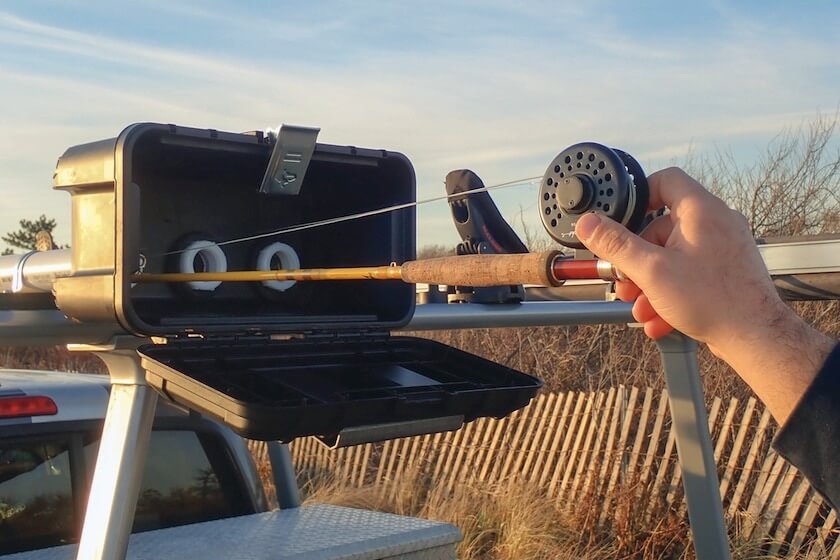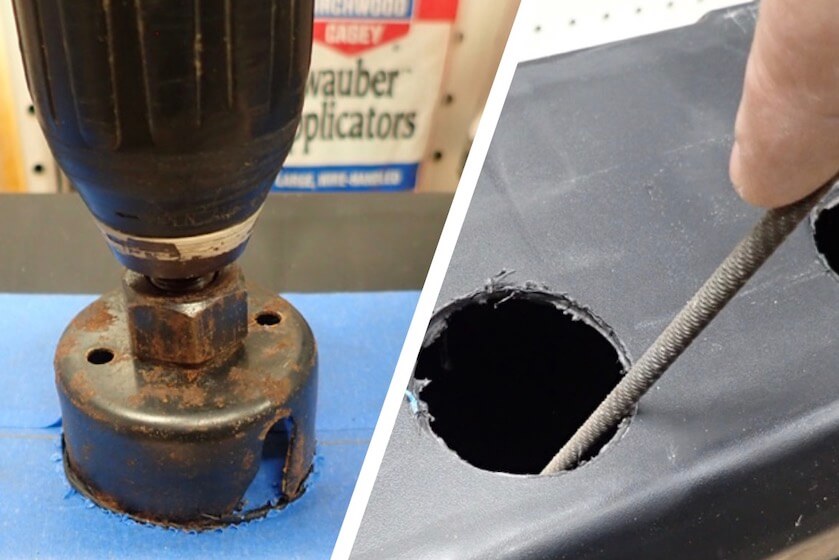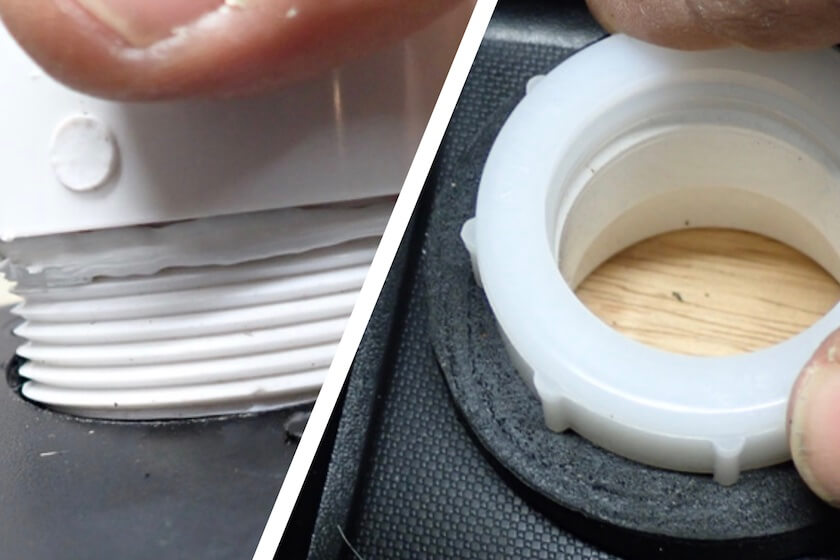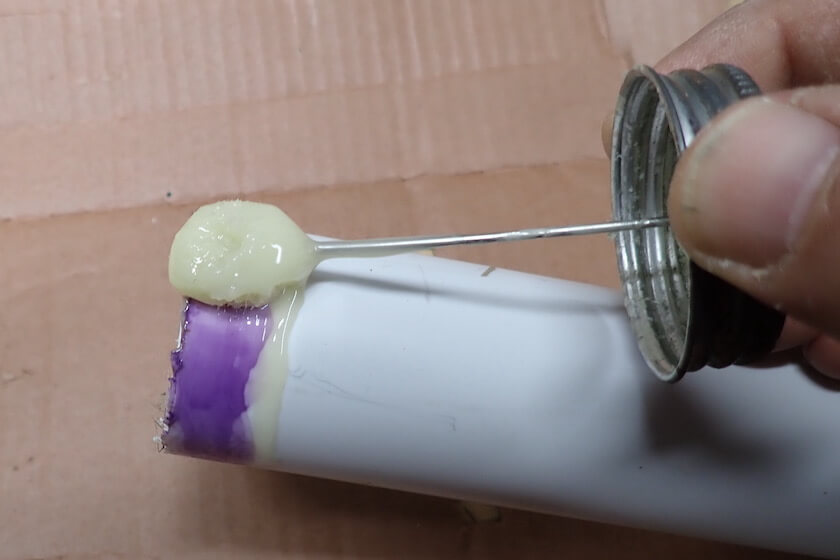
You can make your own roof-top rod carrier in a weekend for about $100. (Photo by Joseph Albanese)
Outfitting your vehicle with a roof-top rod locker means being able to transport your fly rods rigged and ready to fish as soon as you hit the water. With rods secured on the roof, they’re out of the way of passengers, dogs and car doors, and less likely to get broken in transit.
There are many good commercially available rod lockers available (see our Gear section in the April issue), but you can also make your own in a weekend for about $100.
TOOLS NEEDED
- Drill
- Assorted bits
- 1½-inch hole saw
- Circular sawv
- File or sandpaper
- Miter box and saw
- Tape measure and ruler
MATERIALS LIST
- 1 plastic toolbox sized to accommodate reels (mine was 14-by-7-by-7 inches; $7.97)
- 3 10-foot, 11/2-inch PVC pipes ($6.61 each; $19.83 total)
- 3 11/2-inch pipe trap adapters ($1.56 each; $4.68 total)
- 3 11/2-inch PVC caps ($1.14 each; $3.42 total)
- 3 tub-drain gaskets ($2.73 each; $8.19 total)
- 6 ¾-inch foam pipe insulation ($2.47 each; $14.82 total)
- 12 size 12, ½-inch screws ($1.18 per 10; $2.36 total)
- 6 1½-inch galvanized two-hole pipe hanger straps ($0.52 each; $3.12 total) ¾-inch plywood or dimensional lumber of similar thickness (project panel about $10)
- 4 M8 T-bolts ($4.49)
- 4 M8 hex flange lock nuts ($5.59)
- Exterior paint ($4.98)
- PVC primer and glue ($7.70)
- Silicone caulk ($2.58)
Total: $99.73
Step 1

Begin by laying out the locations of the holes for the rod tubes on the toolbox. Cover the bottom of the toolbox with masking tape to make marking easier and place the trap adapters, without caps, in their approximate locations. I put one directly in the middle and the others 2 inches in from the sides, but do what works best for you.
Step 2

Drill holes through the box bottom in the marked locations. Start with pilot holes, followed by the hole saw. Go slowly, applying gentle pressure. I found I could make a cleaner hole by putting the drill in reverse but be aware that the nut holding the blade on the arbor will loosen. After the 1 1/2-inch holes are cut, clean up the edges using a round file or sandpaper wrapped around a dowel.
Step 3

Connect the trap adapters to the holes. Apply a bead of silicone sealant around the threaded portion of each adapter and insert it into the hole. Once seated, place a tub-drain gasket on the back (interior) side and secure it with the nut.
Step 4

Cut the PVC pipes an appropriate length to fit your rods, then stuff the pipes with foam insulation, which will cushion your rods over rough roads. Leave the first 8 inches of the end that will be inserted into the toolbox free of insulation to accommodate the rod handle and large stripper guide. Cut the insultation at the other end flush with the pipe. Skip this step altogether if you have a rod with large guides along its entire length.
Step 5

Before everything gets glued together, you’ll want to have the bracket bases ready. I used a piece of 3/4-inch plywood as long as the toolbox, ripped down to a 2-inch width to fit my roof rack’s crossbars. Make your cuts with a circular saw and fine-tooth blade to ensure you don’t chip the wood. I drilled a hole in each end of the bases for the T-bolts I used to attach the carrier to the roof rack. Alternatively, you can secure the bases to a rack’s crossbars with U-bolt clamps, in which case drilling holes isn’t necessary. Give the plywood a coat of exterior paint to protect it from the elements.
Step 6

It’s time to put everything together. It doesn’t matter if you put the caps on your pipes or attach the pipes to the toolbox first, but it will be easier to focus on one end at a time. PVC cement isn’t glue, but rather a solvent that bonds two pieces together by melting the surfaces and fusing them; they re-harden quickly, so you have to work fast. Hit each side with primer so they’re clean and follow with the cement. Press the components together and rotate them to ensure the connection is evenly coated.
Step 7

Decide whether you want your rods to rest reel-up or reel-down, and orient the toolbox to accommodate that desire. Lay the bracket bases under the PVC pipes, and place the pipe straps over the pipes. Once everything is lined up, drill pilot holes and secure the straps using the 1/2-inch screws. Repeat the process for the second base, but leave the screws loose so that you can slide it to align with your rack’s front crossbar.
Step 8

Mount the rod locker to your roof rack. Position the plywood bases so they line up with the crossbars, and attach them. As mentioned, I used T-bolts that slide into the extruded channels in my rack. If you use U-bolt clamps, place them between the pipes to ensure they don’t walk out. Once the T-bolts or U-bolts are snug, tighten the screws holding the pipe straps to the front base. Throw your rods in the tubes and hit the road.






![Air gun 101: The differences between .177 & .22 – Which jobs they do best ? [Infographic]](https://airgunmaniac.com/wp-content/uploads/2020/09/g44-218x150.jpg)



































